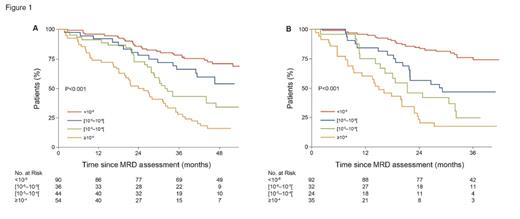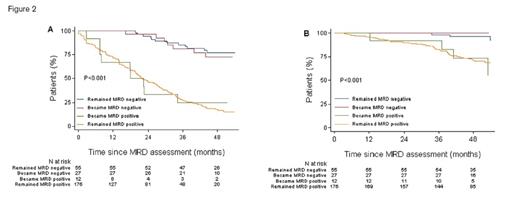Although multiple myeloma (MM) has long been considered incurable, newer therapeutic agents have led to such dramatic improvements in overall survival (OS) that earlier surrogate endpoints are essential for realistic and relevant clinical trial design. Furthermore, complete response (CR) rates have risen (as high as 80% with current treatment strategies) such that the achievement of CR may no longer be sufficiently sensitive for outcome prediction.
Measurable residual disease (MRD, also referred to as “minimal residual disease”) assessment has been used in various hematologic malignancies as both an early and an analytically sensitive evaluation of disease response to therapy. The utility of MRD measurements in the context of MM was highlighted in a meta-analysis by Dr. Nikhil C. Munshi and colleagues. This study showed a 40 to 73 percent reduction in risk of progression and mortality in patients who achieved MRD negativity by multiparametric flow cytometry (MFC) or allele-specific oligonucleotide polymerase chain reaction (ASO-PCR) –based methods.1 Differences between the hazard ratios in part reflect alterations in sensitivity of different MRD tests (MFC typically at least 10–4, ASO-PCR typically at least 10–5). Additionally, there are differences in clinical detection rates, with MFC having more wide applicability than ASO-PCR. In theory, deep sequencing of clonotypic rearrangements by next-generation sequencing (NGS) can achieve greater analytical sensitivity in assessing MRD (<10−5) and therefore may prove superior to these other methods in predicting outcomes in myeloma. Although data are limited, retrospective studies have compared the results of NGS with either MFC or ASO-PCR.2,3 These studies demonstrated the applicability of this approach to 90 to 91 percent of patients and the prognostic significance of MRD status by NGS in terms of progression free survival (PFS) and OS after induction chemotherapy and after autologous stem-cell transplantation.
Progression-free survival stratified by level of measurable residual disease at the start of maintenance therapy (A) and after 12 months of maintenance therapy (B) in patients with a very good partial response or better. From Supplemental Figure 1 in Perrot et al., Blood. 2018;132:2456-2464.
Progression-free survival stratified by level of measurable residual disease at the start of maintenance therapy (A) and after 12 months of maintenance therapy (B) in patients with a very good partial response or better. From Supplemental Figure 1 in Perrot et al., Blood. 2018;132:2456-2464.
A study published recently by Dr. Aurore Perrot and colleagues addresses the significance of serial MRD assessment by NGS using data from the phase III Intergroupe Francophone du Myélome (IFM) 2009 clinical trial, which evaluated the role of transplantation in patients with newly diagnosed myeloma treated with lenalidomide, bortezomib, and dexamethasone. The baseline clonal immunoglobulin gene rearrangements were defined using bone marrow aspirate enriched for CD138-positive plasma cells collected at enrollment. Subsequent samples were examined for MRD status before and after maintenance in patients achieving a very good partial response or better. The authors demonstrated that similar percentages of patients achieved MRD negativity (defined as <10–6) regardless of the treatment and other known prognostic factors such as stage of disease at diagnosis or cytogenetic risk profile, although those with del(17p) were less likely to achieve this status within the high-risk cytogenetic category. Patients who achieved MRD negativity at either timepoint had an improved PFS and OS at four years (from start of maintenance) compared to patients who were MRD positive; additionally, the level of measurable disease correlated with outcomes (Figure 1). Overall, MRD negativity alone conferred approximately 80 percent relative risk reduction.
The serial assessment of the study allowed the researchers to identify a subset of patients who changed MRD status after 12 months of maintenance therapy. A total of 10 percent of patients (27 of 270 patients) became MRD negative after maintenance, while 5 percent (12 of 270) became MRD positive despite being initially MRD negative. Interestingly, both PFS and OS were similar for patients with the same MRD status at the end of maintenance, regardless of their status at the initiation of maintenance (Figure 2). Further studies are required to determine if increased therapy at the early identification of relapse will affect the OS.
Kaplan-Meier survival curves for progression-free survival (A) and overall survival (B) based upon measurable residual disease (MRD) status at the beginning versus the end of maintenance therapy. From Supplemental Figure 8 in Perrot et al., Blood. 2018;132:2456-2464.
Kaplan-Meier survival curves for progression-free survival (A) and overall survival (B) based upon measurable residual disease (MRD) status at the beginning versus the end of maintenance therapy. From Supplemental Figure 8 in Perrot et al., Blood. 2018;132:2456-2464.
Two issues with this approach are evident. First, serial measurements for close monitoring of patients necessitates increased frequency of bone marrow biopsies. Second, bone marrow involvement is notoriously patchy, favoring a more wholistic assessment of response. In theory, the assessment of MRD in circulating tumor DNA (ctDNA) would address both these issues. However, recent work by Dr. Céline Mazzotti and colleagues demonstrated that 69 percent of MM patients who are bone marrow MRD positive by NGS do not have detectable ctDNA (18 of 26 cases), with an overall concordance rate of the two samples of only 49 percent.4
In Brief
In conclusion, Dr. Perrot and colleagues have demonstrated the effective stratification of outcomes based upon the level of MRD as measured by NGS detection of clonotypes, supporting the concept of “the deeper, the better.” Serial evaluation of MRD demonstrated that up to 10 percent of patients can change MRD status during maintenance chemotherapy and that outcomes are dictated by the final MRD status at the end of maintenance. Although the NGS methodology used here fulfils many of the characteristics for an ideal MRD test as defined by Myeloma Working Group 6,5 the authors are careful to assert that likely any methodology with sufficient analytical sensitivity would provide similar results, but, in a separate study, ctDNA seems to be insufficiently sensitive/representative in myeloma. Additional studies will be required to determine the most informative and cost-effective time points for monitoring and appropriate interventions for MRD positive patients.
References
Competing Interests
Dr. Ouseph and Dr. Kim indicated no relevant conflicts of interest.


